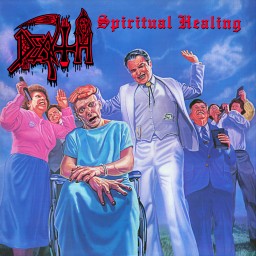 Review by Ben for Death - Spiritual Healing (1990)
Review by Ben for Death - Spiritual Healing (1990)
Another step up in maturity for Death, Spiritual Healing is an underappreciated display of courage.
Given the band’s tumultuous history, it’s not surprising that the line-up between Leprosy and Spiritual Healing had changed. By the end of 1989, Chuck and second guitarist Rick Rozz were constantly in conflict, with the end result being that Rick was removed from the band. Chuck later stated the main reason this occurred was due to Rick’s unwillingness (or inability) to progress as a musician and given the band’s progressive ambitions, they needed to find a suitably talented replacement. James Murphy was that man. These days Murphy is a metal legend after being involved in albums by Obituary, Testament, Cancer and Disincarnate, not to mention several mostly instrumental albums released under his own name. His lead guitar work is brilliant and the ease at which he performs it highly admirable. At the time Chuck handpicked him to join Death, he was known only for his connection with thrash metal bands Agent Steel and Hallow’s Eve, yet had very little studio experience. That was all about to change though, as in the summer of 1989, Chuck, James, Terry Butler and Bill Andrews would enter the infamous Morrisound studio to record Spiritual Healing. It’s worth noting that this was also the first time Terry Butler had performed on a Death album, as Chuck performed bass on Leprosy despite Terry being listed as such on the album sleeve.
While these four musicians knew what their ultimate goal was at the time, it’s safe to say that many of the band’s fans did not. Death’s previous album Leprosy was a genre classic. It gave death metal an unprecedented brutality while still remaining entirely memorable and entertaining. All eyes were on Chuck to see what he’d unleash next with most fans expecting something even more brutal and shredding. Looking back, it’s not particularly surprising that a lot of these fans were a bit disappointed with the end result, but I believe this response had more to do with expectations rather than the quality of the material. Death chose to evolve away from the raw, vicious approach of their earlier albums and take on a more technical and mature style. The gory, violent lyrics were gone, replaced with social commentary regarding important issues such as abortion, religion and genetics. The ferocious, thrashy production of yesteryear was replaced with a clear Scott Burns driven, instrument focused sound this time round. Above all, the musicianship in general stepped up a level of technicality with exquisite leads and varied time signatures combining with the more standard death metal trappings. Chuck would expand on this over the next few releases of course, but Spiritual Healing deserves credit for getting the evolution well and truly off the ground.
It needs to be said though, that Spiritual Healing is not a flawless effort. As you would expect for a band trying to break new ground, not everything clicks the way it does on later albums such as Human, Individual Thought Patterns and Symbolic. For all the fantastic guitar work by Murphy and Schuldiner, drummer Bill Andrews is an obvious weak point. He does tinker with odd timings and there’s some nice double bass kicking, but in general his performance is simply too monotonous for an album with such a progressive attitude. Terry’s bass is adequate enough, but pales in comparison to the jaw dropping work of the session musicians Chuck would call on for future albums such as Steve DiGiorgio. Weaknesses aside, the song writing is totally compelling, with top riffs pumped out consistently throughout. Chuck’s vocals are powerful and venomous yet entirely decipherable which is perfect for the lyrical content and musical style of the album. Chuck stated prior to the release that “we believe that we can turn a few more people into death metal with this record and change a lot of people’s minds about what death metal is supposed to sound like”. I believe they did just that, and tracks like Living Monstrosity, Altering the Future, Spiritual Healing and Genetic Reconstruction sit perfectly well amongst the best work in Death’s discography. An underappreciated album!
Sidenote: Spiritual Healing is the third and final Death album to contain artwork by Edward J. Repka. The artist is undoubtedly more known in the world of thrash metal where he’s made a strong resurgence due to the recent thrash revival. I think the three covers he produced for Death are among his best work. He brilliantly nailed the themes of each release and, despite his easily recognisable style, gave each piece entirely distinctive looks. One thing that makes Repka’s covers so unique is his use of colour. The purple of the skeleton’s robe on Scream Bloody Gore, the pink of the sky on Leprosy, the variety of blues that characterise Spiritual Healing. These are colours not often associated with death metal and yet they’re all so striking while taking nothing away from the morbid edge so necessary for albums of this genre. The cover for Spiritual Healing is the best of the three, mostly due to the way it presents its message so clearly with both humour and realism. The smugness and near psychotic worship of the faithful are juxtaposed by the sheer terror of their subject. The cash is placed so precisely to remind us of the healer’s true intentions. I feel disgust at the truth of it and yet laugh at the painting’s satirical tone. These characteristics are prevalent through nearly all of Repka’s album covers and it’s fantastic to find the man still cranking them out.
